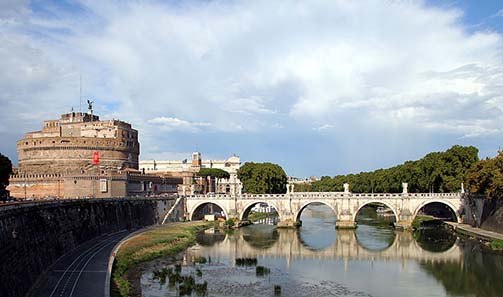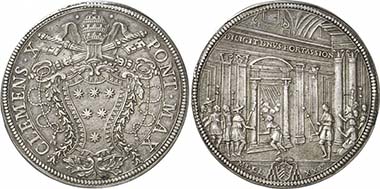Strictly speaking, he is no shining light in the history of the Church, this Boniface VII who had imprisoned his abdicated predecessor Celestine V until his death, who, with his Bull Unam sanctam, laid claim to Papal world dominion and whose aspirations were deeply abased by Philipp IV of France: he is responsible for the “Captivity of the Papacy”. Surely no one is inclined to think of that when it is about the holy year of the Catholic Church. After all, we owe this Pope the highly successful institution of a regular festivity during which a pilgrim to Rome could get a particular high remission of sins. In 1300 after the incarnation of God, Boniface VIII decided that for an entire year every Roman who visited the four basilicas in Rome for 30 days and every pilgrim doing the same for 15 days, should be granted a particular indulgence of his sins. This was to be repeated after a period of 100 years.
Porte Sant’Angelo in Rome. Photograph: AngMoKio / Wikipedia.
The holy year was a huge success. The pilgrims came in such great numbers that the Porte Sant’Angelo, by then the only way across the Tiber River, had to be divided with wooden planks into two footways, one for everyone on either side. Thus, it didn’t take 100 years, but only 50 until Clement VI proclaimed a new holy year; his successors didn’t even let 50 years lapse away, but only 40, then 10 and again 23. In 1390, 1400 and 1423, the next holy years were celebrated. By then, no coins or medals were issued on that occasion yet. That changed in 1450, when Nicholas V called the pilgrims for a special remission. That year was rather ill-fated: Cholera broke out in Rome and caused the Holy Father to lower the original period of church attendances from 30 and 15 days, respectively, to five days. In addition, a severe accident happened on the Porte Sant’Angelo. 172 pilgrims were squashed to death in a panic.
Nicholas V, 1447-1455. Grosso n. dJ. (1450) on the Holy Year. From auction Hauck & Aufhäuser 18 (2004), 969.
This isn’t mirrored at all in the first commemorative coinage on a holy year. Keys and tiara on the obverse of the coin indicate that the successor of Saint Peter is awarded an infinite realm. The Pope has the power of binding and loosing. Saints Peter and Paul on the coin’s reverse seem to guarantee this power. This coinage still betrays the spirit of Medieval times but at the same time sounds the bell for the early Renaissance that identified events as a part of history and wanted to hand them down to future generation on medals.
We are at humanism’s door, the return to ancient traditions. Thus, Nicholas is not only the first Pope who had a commemorative coinage on the occasion of the Holy Year produced but who ventured a step into the new era with the intention to rebuild St. Peter’s Church and who acquired the first 5,000 precious manuscripts for the recently founded Vatican Library from the proceeds of the never-ending flow of pilgrims.
Sixtus IV. 1471-1484. Fiorino di camera n.d. Rev. Saint Peter as fisherman. From auction Künker 171 (2010), 5221.
Nicholas V ordered the interval between the holy years to be 50 years and, consequently, the next one was celebrated in 1475 – surprising how short 50 years can be. We are right in the middle of the Renaissance by now. Pope Sixtus IV was a patron of the arts who had the Sistine Chapel erected; he finally started cataloguing the Papal art treasures, instituted the Swiss Guards and had the Trevi Fountain built, not only for the decoration of the cityscape but to make it possible for the population of Rome to get its drinking water from there. Of course, he had coins and medals produced on the occasion of the holy year: a splendid and truly rare medal showing Christ, the good shepherd, entrusting the flock of believers to Saint Peter. On the reverse it depicts the famous episode from the New Testament of the Apostles crossing the stormy sea all alone on a ship who are approached by Christ, walking on the very waves, to calm them. This parable found entrance into the iconographic repertoire of the Church which often referred to itself as a ship sliding on the stormy sea, guided by the successor of Saint Peter. The Papal gold coin hints at that picture: it shows Saint Peter as the true fisherman bringing the souls of man into the boat of the Holy Roman Church.
Sixtus IV. 1471-1484. Bronze medal. Rev. The Holy Door. From auction CNG Electronic Auction 210 (2009), 352.
Another bronze medal was issued that showed the Holy Door for the first time ever.
Clement X, 1670-1676. Piaster 1675. From auction Gorny & Mosch 192 (2010), 3831.
1525, 1550, 1575, and 1600 – the holy year was now celebrated every 25 years. Let us skip some festivities and go directly to 1675. We have arrived in Baroque times, when in Austria, Bavaria, Baden and Wuerttemberg all these magnificent churches were built that celebrated the victory of the counterreformation. In Rome, Clement X opened the Holy Door. Or rather, he didn’t. 200,000 pilgrims saw the Holy Father suffering an attack of gout with the result that Cardinal Orsini had to complete the ceremony. Some of these believers are shown on the Testone issued on the occasion of that holy year. One was Christina of Sweden who was so impressed by the Catholic pomp and the immanent joy of living that she renounced her Protestant belief and hence abdicated the Swedish throne.
Leo XII, 1823-1829. Medal 1825 on the opening of the Holy Door. From auction Tkalec (May 7, 2008), 689.
Again 150 years later. The Church had lost much influence due to the different spiritual and political revolutions in the world. The Holy Year, however, is a big success yet again and 400,000 believers attend. But this time they cannot visit the Basilica of Saint Paul Outside the Walls since it had burnt to the ground in 1823 in a disastrous fire. They pray in the Basilica of Our Lady in Trastevere instead. Gorgeously, the Pope with the entire court faces us on the medal that shows the opening of the Holy Door.
Will it be equally gorgeous when a Pope opens the Holy Door the next time and invites pilgrims from all over the world? In any case, it was in 2008, under Pope Benedict XVI, that the last extraordinary Holy Year was celebrated in honor of Saint Peter.











